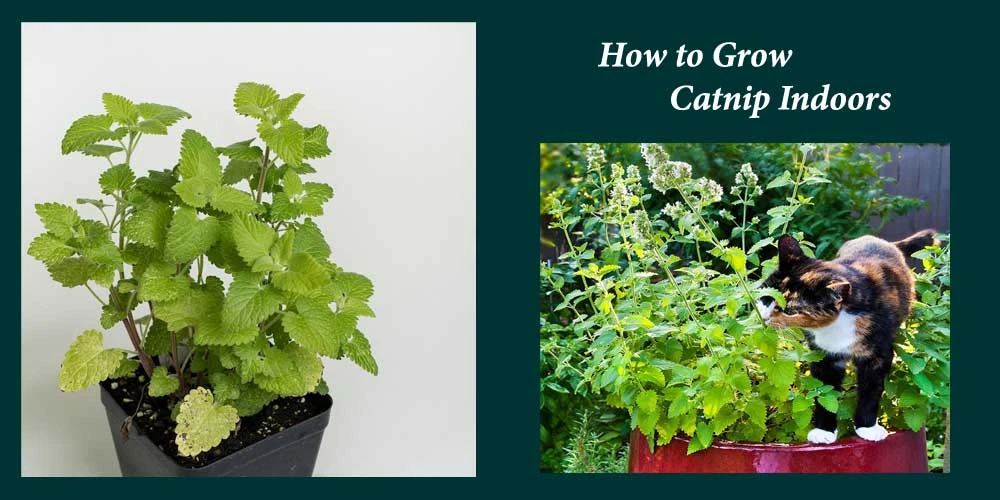reviewed by Christina Lopez
Are you a cat lover? Want to know How to grow catnip indoors? Read the article and discover how can you grow catnip indoors!
Catnip is an easy-to-grow perennial grown primarily for its fragrant foliage that is extremely attractive to cats. It is fragrant foliage, an easy-to-grow plant. The plants extremely attract the feline-like cat. It is a mint family herb and known for attracting cats like a magician. This gray-green foliage plant releases a chemical called nepetalactone when rubbed, which works as a cat attractant. Catnip is also used to flavor salads, teas, and meat dishes. Overall, it’s a useful herb, and you can also grow it as a houseplant
Contents
The adynamic plant easily grows indoors. So, Growing Catnip Indoors is possible. With the help of the following tips, you can easily grow catnip indoors. You can grow it year-round in your home. All you need is a place of bright sunny, and airy place.
Plant it in a location where it is easily controlled. You can easily control the location of your catnip. For growing catnip indoors, remove the flower heads before they mature and set seeds. Collect catnip leaves at any time to feed your feline. You can store the dry leaves of indoor catnip for your kitties. The aromatic foliage can be useful to repel mosquitoes.
Now, are you interested to know how to grow catnip indoors for the feline catnip? Why wouldn’t you be?
Catnip is not only for cat owners but also a delightful addition to the early gardener. It a high consumable item and has nutritious value. The tea of catnip plants helps to reduce stress and digestion.

Growing catnip indoors is very simple, and you have to provide your plant as much sunlight as possible. Less sunlight may hamper plant growth and production indoor. The pot of quick-draining water always discourages root rot. To grow catnip planting indoor, the soil pot should be equipped with enough drainage system. If the soil holds too much moisture, it may cause problems and often cause the root for your catnip plants.
Fertilizer is an important component to grow catnip plants indoors. All you need a good fertilizer to grow more catnip. Choose a good fertilizer from the market, mix the fertilizer with soil by maintaining proper ration, water the mix, remain in the soil for 3-4 days, and plant your desire catnip species. You can transfer and produce new catnip by cutting and putting in a new pot.
Make sure of enough space for your catnip. Please make sure that your indoor catnip has room to breathe by spacing your pots for proper gardening practice. Always try to grow your catnip plants bit outside by properly knowing how to grow catnip indoors. A balcony or empty lawn/space is the perfect place to try your hand at growing the ‘nip.
Growing as well as maintain catnip plants indoors is a bit challenging task. Bugs are major problems at home for catnip plants. At the nursery, you should consider and hold a good quality pesticide. Before planting a new seedling, a good pesticide is a prerequisite for a new catnip plant. So think twice before you begin to grow catnip plants indoors.
Periodically, cut off any budding stems to enhance your plant growth.
Ensure limited access to your feline. As mentioned earlier, cats are often disturbing to your indoor catnip. They will wreck your plant by rubbing up against or sitting in it. Use a hanging pot to avoid certain occurrences by your feline.
Drown your catnip. Make sure your container has enough drainage facilities or have enough holes! Over moisture is often reducing the production of your catnips. Stagnant water sitting in the bottom of a closed port will be hazardous.
Ensure limited moisture on the leaves. Bugs species are often deadly to catnip your indoor plants. These bugs have close relation with watering. Over or direct watering encourages bugs and mold. So, when you water, pour directly on the soil, not on top of the foliage.
Don’t forget to water it. Periodical watering is a good practice to ensure healthy catnip indoor. Catnip will recover with a healthy dose of H2O.
Recycle potting soil. If you’ve lost a plant to fungus or pests, they still might be living in the soil. Toss the infected mix and wash the pot with hot soap and water before using it again.
The Catnip propagates easily from both leaf-tip cuttings and seeds. I always avoid cutting the piece to grow a new potting for catnips. You can use a rooting hormone to increase the chances of success. Use a fresh container and sterile potting soil to reproduce catnip indoor. Keep the breaking moist and in filtered light until it sprouts new life.
Catnip is also a common herb sold in different growth centers around you. So you can always buy new seedlings and transplant them into larger pots until it’s time to discard the plant.
The Catnip species generally grow two to three feet tall outdoors. It is a perennial plant that generally grows Indoors if you are willing to provide enough sunlight and the right amount of water. It might grow up to two feet tall but not as tall when grown outdoors.
Actuality, indoor catnip doesn’t have the effectiveness of grown outdoors. It seems more reasonable to grow plants indoors only for a growing season. You can propagate new plants by sowing new seeds or taking cuttings and rooting them.
If you want to report a catnip plant, increase pot size larger, use fresh potting soil. Please, be careful not to damage the root system.
Did you know: Cats can’t engulf more catnip? When they’ve had enough, they’ll turn it away and refuse to eat or play with it.
Fun facts: The ornamental catnip species attracts the feline group and the different insects like butterflies and moths.
Catnips are rewarding plants. They provide a good flow of nutrients to human beings as well as felines. You can enjoy an aesthetic scene when it grows healthy catnips indoor. It’s might real pleasure to the entire early gardener. Please, put a serious note that catnips can be invasive sometimes and can cause damage to other species of your garden. So, you should maintain the overall growth of catnip indoor. So, from all the narrative, now you know how to grow catnip indoors?
 |
 |
 |
 |

About Christina Lopez
Christina Lopez grew up in the scenic city of Mountain View, California. For eighteen ascetic years, she refrained from eating meat until she discovered the exquisite delicacy of chicken thighs. Christina is a city finalist competitive pingpong player, an ocean diver, and an ex-pat in England and Japan. Currently, she is a computer science doctoral student. Christina writes late at night; most of her daytime is spent enchanting her magical herb garden.
 |
 |
 |
 |
Check These Out
Get new FREE Gifts. Or latest free growing e-books from our latest works.
Disable Ad block to reveal all the links. Once done, hit a button below
 |
 |
 |
 |